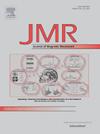Easy-to-implement passive shimming approach of Halbach magnet for low-field NMR measurement
IF 1.9
3区 化学
Q3 BIOCHEMICAL RESEARCH METHODS
引用次数: 0
Abstract
Halbach magnets have been widely employed to NMR instruments due to their low weight, low cost, and minimal leakage of magnetic field. However, field inhomogeneity remains challenge due to discrete magnet rings and manufacturing deviations of the magnetic elements. This paper aims to address this limitation through an effective passive shimming approach, which is considered the first step toward constructing high-homogeneity magnets because of its non-powered and inherently stable characteristics. We focus on the transverse dipole field generated by Halbach magnets and develop an easily implementable linear programming-genetic algorithm (LP-GA) hybrid optimization approach for passive shimming. Our methodology first employs an equivalent magnetic dipole model to calculate the sensitivity matrix of the shim pieces in the Region of Interest (ROI). Then, the LP-GA hybrid optimization algorithm determines the optimal position, number, and thickness of the shim pieces. By combining shim pieces of three different thicknesses (1 mm, 1.5 mm, and 2 mm), we significantly reduce the field inhomogeneity of a 48 mT Halbach magnet system. The effectiveness of our approach is validated through NMR measurements using water samples with copper sulfate at different concentrations, demonstrating an improvement in field homogeneity from approximately 1229 ppm to 320 ppm. The experimental results confirm that the proposed approach effectively enhances magnetic field homogeneity of low-field Halbach magnet systems and could be applied to shimming various Halbach-like magnet arrays.

用于低场核磁共振测量的易于实现的Halbach磁体被动摆振方法
哈尔巴赫磁体具有重量轻、成本低、磁场泄漏小等优点,已广泛应用于核磁共振仪器中。然而,由于磁环的离散和磁性元件的制造偏差,磁场的不均匀性仍然是一个挑战。本文旨在通过一种有效的被动摆振方法来解决这一限制,由于其无动力和固有稳定的特性,该方法被认为是构建高均匀性磁铁的第一步。针对Halbach磁体产生的横向偶极子场,提出了一种易于实现的线性规划-遗传算法(LP-GA)混合优化方法。我们的方法首先采用等效磁偶极子模型来计算感兴趣区域(ROI)中垫片的灵敏度矩阵。然后,采用LP-GA混合优化算法确定垫片的最佳位置、数量和厚度。通过组合三种不同厚度的薄片(1mm、1.5 mm和2mm),我们显著降低了48mt Halbach磁体系统的场不均匀性。通过使用不同浓度的硫酸铜水样进行核磁共振测量,验证了我们方法的有效性,表明现场均匀性从大约1229 ppm提高到320 ppm。实验结果表明,该方法有效地提高了低场哈尔巴赫磁体系统的磁场均匀性,可用于各种类哈尔巴赫磁体阵列的调光。
本文章由计算机程序翻译,如有差异,请以英文原文为准。
求助全文
约1分钟内获得全文
求助全文
来源期刊
CiteScore
3.80
自引率
13.60%
发文量
150
审稿时长
69 days
期刊介绍:
The Journal of Magnetic Resonance presents original technical and scientific papers in all aspects of magnetic resonance, including nuclear magnetic resonance spectroscopy (NMR) of solids and liquids, electron spin/paramagnetic resonance (EPR), in vivo magnetic resonance imaging (MRI) and spectroscopy (MRS), nuclear quadrupole resonance (NQR) and magnetic resonance phenomena at nearly zero fields or in combination with optics. The Journal''s main aims include deepening the physical principles underlying all these spectroscopies, publishing significant theoretical and experimental results leading to spectral and spatial progress in these areas, and opening new MR-based applications in chemistry, biology and medicine. The Journal also seeks descriptions of novel apparatuses, new experimental protocols, and new procedures of data analysis and interpretation - including computational and quantum-mechanical methods - capable of advancing MR spectroscopy and imaging.

 求助内容:
求助内容: 应助结果提醒方式:
应助结果提醒方式:


